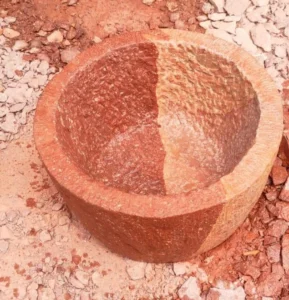What is the difference between Dholpur stone and sandstone?
The confusion between Dholpur stone and sandstone arises from the fact that Dholpur stone is actually a type of sandstone. However, not all sandstone is Dholpur stone. To understand the differences, it’s important to explore both these terms in detail.
What is Sandstone?
Sandstone is a sedimentary rock composed mainly of sand-sized mineral particles or rock fragments. These particles are typically composed of quartz or feldspar, which are the most abundant minerals in the Earth’s crust. Sandstone is noted for its wide range of colors and textures, which depend on the source and type of minerals and organic material present in the rock.
Key Properties of Sandstone:
- Composition: Primarily quartz and feldspar.
- Texture: Can vary from fine to coarse-grained.
- Color: Ranges widely from whites, yellows, reds, to browns and greys.
- Durability: Generally durable, but varies with composition and bonding materials.
- Porosity: Varies, leading to different levels of water absorption and weather resistance.
What is Dholpur Stone?
Dholpur stone, specifically, is a type of sandstone quarried in the Dholpur district of Rajasthan, India. It is known for its specific qualities that distinguish it from other types of sandstone.
Distinct Properties of Dholpur Stone:
- Color and Texture: Predominantly available in pink, red, beige, and cream hues with a fine-grained texture.
- Consistency: More consistent in color and texture compared to general sandstone varieties.
- Durability and Strength: Known for its high durability and strength, making it suitable for heavy-duty construction.
- Cultural Significance: Widely used in historic Indian architecture, adding a cultural value to it.
- Thermal Properties: Exhibits good thermal resistance, beneficial in areas with fluctuating temperatures.
Differences Between Dholpur Stone and General Sandstone:
Geographical Origin: Dholpur stone is specifically quarried in Dholpur, whereas sandstone is sourced from various locations globally.
Color and Texture Consistency: Dholpur stone tends to have a more consistent color and texture than generic sandstone, which can vary widely depending on its place of origin.
Cultural and Historical Significance: Dholpur stone holds a special place in Indian architecture and history, a trait that general sandstone may not possess.
Specific Usage: Due to its specific properties, Dholpur stone is often chosen for particular architectural projects, especially in India, whereas sandstone, in general, is used in a variety of contexts worldwide.
Pricing and Availability: The pricing and availability of Dholpur stone can be different from other sandstone varieties, influenced by its demand and quarrying location.
Conclusion
While Dholpur stone is a type of sandstone, it stands out due to its specific properties, cultural significance, and geographical origin. Understanding these differences is crucial, especially for architects, builders, and those interested in historical construction, as it influences the choice of material for various construction projects.


